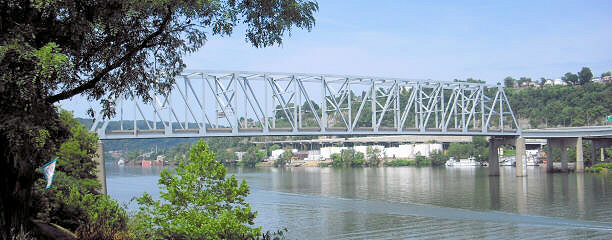 The Jennings Randolph Bridge was constructed after the Chester Bridge was closed down on May 14, 1969. The Jennings Randolph Bridge was constructed after the Chester Bridge was closed down on May 14, 1969. Early on during its construction, there was a drive to name it after Marine General Keith B. McCutcheon, a native of East Liverpool who died on July 13, 1971. A petition was submitted with 3,335 signatures - 2,036 from East Liverpool and 1,190 from Chester and Newell. It would eventually be named after Senator Jennings Randolph (1902-1998) of West Virginia.
On May 16, 1969, Governor Arch Moore of West Virginia and Governor James Rhodes of Ohio met in East Liverpool to agree on the site of the new bridge. Plans were drawn up and approved by the Coast Guard on October 23, 1970. At this time, it was believed the bridge would be opened in 1973. The first concrete peirs were poured on June 30, 1971.
The original estimated cost for the bridge was $14 million dollars. This figure was increased in mid-1971 to $20 million. In the end, $47 million was spent to construct the bridge, ramps, and roadways.
Various delays kept pushing the opening date back. These included changes in design, awarding the contractor bids, shortage of materials, namely fuel and steel, availability of funding, a carpenters' strike, and winter weather.
By the end of January 1974, the main span was almost complete and work began on the piers and ramps on the Ohio side. On August 2, 1974, construction began on the concrete approach piers on the West Virginia side.
Work was finally completed in November of 1977 and the bridge was opened to the public on November 7th. It is the largest truss bridge in North America.
The following ran in the East Liverpool Review on opening day:
Closing of the venerable old Chester Bridge in May 1969 put a transportation stranglehold upon the Tri-State District for eight and a half long years.
Despite the limited availability of the Newell toll bridge, West Virginians and Ohioans alike suffered varying degrees of inconvenience and economic loss.
Even more detrimental to the welfare of East Liverpool and Chester areas was the immeasurable loss of growth and development and the delay in realizing key potentials.
With the first use of the new four-lane span across the Ohio River, two cities, two counties, two states are once again united by a free and open flow of traffic.
But the $47 million structure is more than a bridge to Chester, it is a bridge to an opportunity never before realized at this strategic juncture of three states, a major river, a key railroad and two busy limited access highways leading to main east-west, nor-south arteries of the nation.
We now have a Bridge to Somewhere, wherever the people of the Tri-State have the vision and energy and courage to make it lead.
Sources:
The East Liverpool Review, Oct. 16, 1969
The East Liverpool Review, March 21, 1975
The East Liverpool Review, Jan. 3, 1976
The East Liverpool Review, Jan. 10, 1976
The East Liverpool Review, Nov. 7, 1977
|